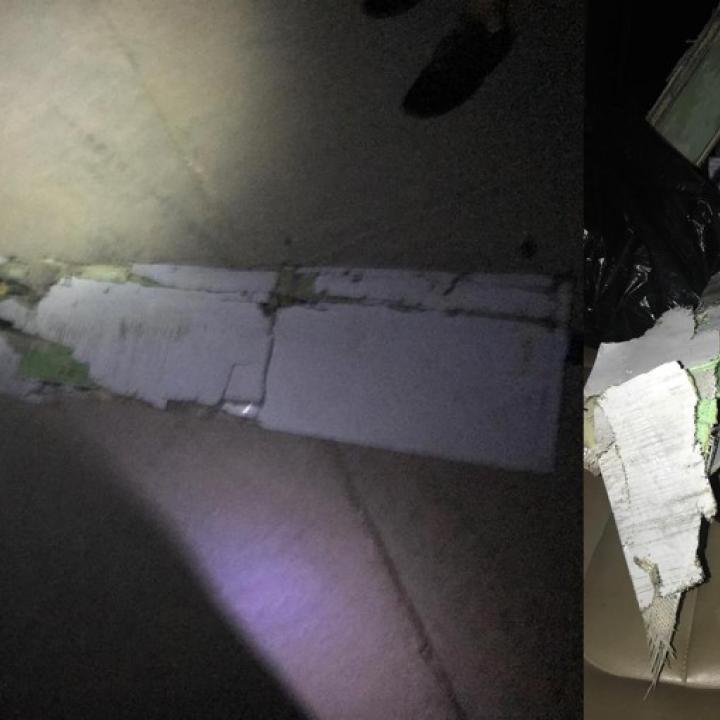
Iran’s Proxies in Iraq Undertake the World's Only Terrorist Attack Commemorating 9/11

Two drones were intercepted in a mission that Sabereen News dedicated to “reminding the Americans of the September 11 attacks."
At 23:43 hours on September 11, two fixed-wing explosive-carrying suicide drones were intercepted by coalition air defenses at Erbil International Airport. Both were damaged and crashed, one just inside the perimeter and one outside, causing no injuries to local civilians or coalition members. As usual, muqawama (resistance) social media channels exaggerated the effectiveness of the attack and posted video and photos of impressive explosions and fireballs to illustrate the purported destruction (see Figure 1)
More interestingly, in a Telegram message that was later taken down, the prominent militia media outlet Sabereen News claimed that the attack was undertaken because “we just wanted to remind the Americans of the Sep. 11 attacks in our own way” (Figure 2). Temporary messages like this are usually deleted in a matter of seconds and are used for internal communication within the muqawama. In this case, the message appears to have been aimed at figures affiliated with Iran's Islamic Revolutionary Guard Corps (IRGC), based on its content and chosen language (Farsi, a relative rarity for Sabereen messages). The post read:
“#temporary [message] [to the] friends of the chatroom. The muqawama guys say tonight's attack doesn’t have anything to do with revenge of the martyrdom of Muhammad in Gando. We just wanted to remind the Americans of the Sep 11 attacks in our own way.”
Somewhat bizarrely, Sabereen seems to be quashing rumors that the drone attack was linked to the portrayed death of a fictional IRGC character in the IRGC-sponsored spy thriller TV series Gando.
Who Ordered the Attack?
A twin-drone attack on Erbil would seem to mark an exception in the recent downturn of drone or rocket attacks on U.S. points of presence in Iraq. (In Syria, however, militias continue to claim attacks, including rocket strikes, on U.S. bases; on September 5, they claimed to fire five rockets at American forces based near the Omar oil field, and on August 31, they claimed two rocket attacks on U.S. forces near the Conoco field.) On June 29, one day after U.S. airstrikes on Iraqi militias, IRGC Qods Force leader Esmail Qaani relayed firm guidance from Supreme Leader Ali Khamenei to Iraqi militia commanders in Baghdad and Najaf, generally warning against further strikes on U.S. locations and specifically emphasizing the importance of not launching drone strikes, which the United States has robustly warned Iran against via various channels. Khamenei’s message also warned that Iran knows who they gave the drones to, and that Iran can take the drones back.
In light of this demarche, the September 11 drone attacks suggest a range intriguing possibilities:
- A muqawama cell undertook an unsanctioned drone attack. This is possible, though it would suggest unsanctioned use of fixed-wing drones that are normally used only by the more disciplined groups (Kataib Hezbollah, Badr, and perhaps Harakat Hezbollah al-Nujaba). However, if Asaib Ahl al-Haq controls such drones as well, then the group might have added to its record of disobeying muqawama ceasefires with a new attack. Also notable was the fact that Kataib Sayyid al-Shuhada made a rare television denial of involvement in the attack. And the Sabereen message regarding 9/11 had the ring of post-facto justification aimed at Iran. Yet even if militias undertook the attack counter to Khamenei's standing guidance, the widespread support it garnered across muqawama channels suggests that the move did not meet with disapproval in Iran. Previously, “unsanctioned” attacks have received a more mixed response or even overt disapproval from some muqawama media quarters.
- A one-time “waiver” to allow the attack. Alternately, Tehran may have loosened its restraints for a 9/11 anniversary attack, or for some other reason (perhaps related to Prime Minister Mustafa al-Kadhimi’s visit to Iran the next day).
- A broader recommencement of attacks. Follow-on attacks would confirm this option, though it would seem odd for Iran to send such a strong warning to its proxies in June only to backtrack after two months.
Militia Spotlight assesses that this attack was likely an Iran-sanctioned exception to mark the anniversary of 9/11 as an anti-American statement, per Sabereen’s claims. Since Qaani’s June 29 demarche, the militias have gradually scaled back their rocket and drone attacks on U.S. sites in Iraq, and this will probably continue until after Iraq's October 10 election. Yet even as they adopt a “wait and see” approach toward the level of U.S. military withdrawal by year's end, the militias also need to be seen as “resisting” the United States. Their main avenue for creating this impression has been by increasing their claims of attacks on trucks that they identify as supplying the U.S.-led coalition. In an example of this kind of largely hollow boast, on September 4, Ashab al-Kahf (a facade group that often claims convoy attacks) declared that it was moving into a “new series of operations” and promised to expand the geographic scope of its actions.








